Radiopacity
Radiolucency
Findings in advanced disease/complications
Sclerosis, focal/diffuse
Impaired healing of extraction sites, lack of bone filling, persisting alveolar sockets
Sequestra
Thickening of the lamina dura
Osteolysis of cortical/spongious bone
Pathological fractures
Prominent mandibular canal
Focal cortical disruption
Signs of sinusitis
Periosteal reaction
Periradicular lucency
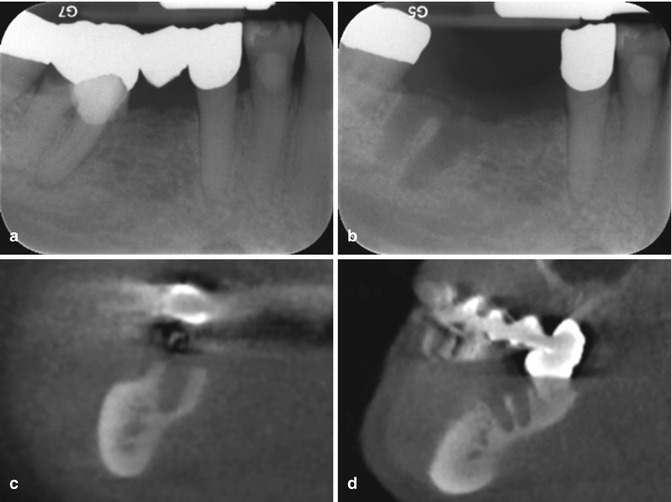
Fig. 6.1
A 70-year-old male presented clinically with a non-healing extraction wound and exposed bone and putrid exudate in the right mandible in region 45–46. Extraction of tooth 46 had been performed 3 months before. The patient received intravenous bisphosphonate therapy with zoledronate (4 mg/month) since 3 and 1/2 years, due to osseous metastases from prostate carcinoma. (a) Plain film radiograph prior to extraction. (b) Plain film radiograph 3 month after extraction of tooth 46. Lack of bone filling and persisting alveolar sockets are obvious. (c) Coronal/(d) sagittal sections derived from CBCT data showing lack of bone filling
Radiologic Tomographic Techniques (CT, CBCT)
In contrast to conventional radiographs, including panoramic radiographs, tomographic techniques like computed tomography (CT) or cone-beam computed tomography (CBCT) allow for three-dimensional evaluation of the jaws. The radiographic signs of BRONJ on panoramic radiographs, which were described above, can be seen in CT images in an analogous way (Table 6.1).
Based on bisphosphonate-induced disorganized bone homeostasis, the affected bone is often associated with sclerosis [14, 15], and consequently, it is a frequent sign seen in radiologic imaging in BRONJ cases (Table 6.1). Sclerosis can range from focal to extended involvement and may have a flocculent or more dense character with irregular trabeculation (Figs. 6.2, 6.4, and 6.6). In advanced lesions, osteonecrosis can present as an inhomogeneous bone density with “cotton-wool” appearance. Dealing with diffuse sclerosis, buccal and lingual cortical bone was reported to be thickened with reduced contrast to the spongious bone [3]. The mandibular canal can present prominently when sclerosis affects the margins of the canal (Figs. 6.3 and 6.4) [3, 5]. Thickening of the alveolar margins and lamina dura is described as well [3, 5].
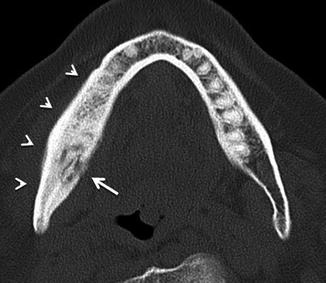
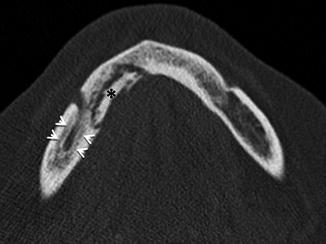
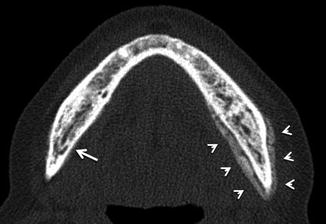

Fig. 6.2
Multislice computed tomography (MSCT). Extended sclerotic changes of the right mandibular corpus and ramus (arrowheads). Sequestration and lingual cortical disruption (large arrow)

Fig. 6.3
BRONJ in the right mandible. Multislice CT depicting a large lingual mandibular sequestration (black asterisk) and prominent mandibular canal (white arrowheads) as sclerosis affects the margins of the canal

Fig. 6.4
Multislice computed tomography (MSCT). Mandible affected by BRONJ. Extended left perimandibular periosteal reaction (arrowheads). Osteosclerosis with disorganized irregular medullary trabeculation throughout the complete mandible. Prominent mandibular canal can be seen at the right mandible (large arrow)
On the other side, osteonecrotic areas feature a loss in bone mineralization and fragmentation and often present with radiolucent areas on panoramic radiographs and lowered attenuation in CT (Table 6.1) (Fig. 6.6) [3, 5, 6, 11, 16].
Several reports suggest significant advantages of CT imaging when compared to panoramic radiographs [5, 6, 9, 13, 17–19]. Location and extension of a lesion may be assessed more exactly by tomography. The dimension of a lesion was proved to be larger on CT and MRI as well as in histopathology than the area of clinically exposed bone [20]. Panoramic radiographs seem to underestimate the dimension of a lesion compared to CT imaging, and the existence of smaller sequestra may be overlooked more easily in panoramic radiographs (Fig. 6.6) [17].
Preoperative knowledge about the extension of a bisphosphonate-related necrosis is valuable for surgical planning. Up to now, there is paucity of available data in this concern. In a study of 24 patients suffering from different stages of BRONJ, panoramic radiographs, CT, and MRI were performed. While detectability of CT and MRI exceeded that of panoramic radiographs by far, it was obvious that CT and MRI presented with difficulties in evaluating the exact extent of the lesions, and so it was concluded that the precision of these both modalities, displaying the extension of osteonecrosis, is limited [9]. Guggenberger et al. (2013) compared extension of bisphosphonate-related lesions in ten patients undergoing PET/CT, contrast-enhanced MRI, panoramic views derived from CBCT, and preoperative and intraoperative assessment. PET/CT and contrast-enhanced MRI were able to display more extensive changes compared with panoramic views derived from CBCT and clinical examination. It was reported that preoperative examination detected smaller extension of the disease than the other examinations. All in all, PET/CT and contrast-enhanced MRI detected more extensive involvement of BRONJ compared with panoramic views from CBCT and clinical examinations [21]. Nonetheless, the latter two studies demonstrate the current limitations of all modalities in order to assess the exact extension of lesion in BRONJ cases. While MRI and PET-CT may overestimate the real lesion dimensions, CBCT imaging as well as preoperative and intraoperative estimations may underestimate the real extension. For the surgeon it is worthwhile to note that for preoperative work-up, these differences between the imaging modalities should be taken into consideration [21]. Further studies are needed and may include precise histopathological assessment and intraoperative assessment with the aid of fluorescence imaging as described in brief in the treatment chapter [22, 23].
Recently, imaging focus also headed toward the possibility to detect MRONJ in an early stage, when there is no presence of clinically exposed bone in the oral cavity. Sclerosis is reported to be a consistent finding in imaging of early disease [3, 16]. In contrast to low-grade or sclerosing osteomyelitis however, periosteal response seems not to be characteristic in early stages (Fig. 6.4) [3, 10].
In a cohort of 32 patients with BRONJ, a cluster analysis was performed on the basis of different radiologic features. Patients were grouped in 4 categories based on CT findings. The authors found a positive correlation with the clinical extension analysis [17]. In contrast, a staging based solely on panoramic radiographs was judged not to be reliable because lesions tend to be underestimated and because of a missing correlation between clinical extension and dental panoramic radiograph clusters [16]. Purulent secretion and sequestration are correlating with the size of osteonecrotic lesions and demonstrated the value of CT imaging in patients with BRONJ [24].
Quantification of imaging features may be promising in order to assess the presence of a bisphosphonate-related bony disorder in an objective manner. CT imaging and consecutive work-up of bone matrix density were performed in patients with confirmed BRONJ and compared with samples from cadaveric controls. Unfortunately, higher bone tissue density was evident only in a subset of BRONJ patients, suggesting that density may have limitations as a biomarker for early detection of this condition [25].
In a retrospective pilot study, different techniques were tested in order to analyze cortical bone dimensional changes caused by bisphosphonates based on CBCT imaging. The evaluation of the mandibular cortical bone at the site of the mental foramen seems to be helpful for the detection of cortical bone dimensional changes. Alterations in the bone architecture were even evident in areas of the mandible, which were not affected by clinical bone exposure. It was concluded that the technique described may aid in detecting early bone alterations helping to predict BRONJ in individuals. However, further longitudinal studies were proposed to verify this technique [12].
Cone-beam computed tomography (CBCT) is a tomographic imaging technique that has become increasingly popular in dentomaxillofacial imaging over the last decade. Within a short imaging time, high-resolution three-dimensional datasets of the head and neck region can be generated. Software applications allow displaying panoramic views as well as multiplanar reconstructions [26]. Furthermore, CBCT imaging comes along with considerably reduced radiation exposure compared to multislice CT protocols [27, 28]. Accordingly, this technique is of increased importance in the setting of BRONJ [10, 12, 29–33].
Radiographic findings (Table 6.1) can be similarly found in CBCT and multidetector CT (Fig. 6.6). However, it hast to be considered that CBCT attenuation measurements are less reliable compared with those in multidetector CT and soft-tissue contrast is lower compared with multidetector CT [34].
Inflammatory affection of soft tissues like cervical lymphadenopathy, mass-like thickening of the masticator muscles, and abscess formation are addressed more properly with multidetector CT imaging or MRI, especially if imaging is contrast enhanced.
Further radiographic findings in advanced disease that should be kept in mind are sequestra, pathological fractures, and maxillary sinus affection (Figs. 6.2, 6.3, 6.5, and 6.6) [35, 36]. These findings should be given special attention and three-dimensional imaging modalities are strongly recommended in this context. For example, panoramic radiographs seem to underestimate the dimension of a lesion compared to CT imaging, and the existence of smaller sequestra may be overlooked more easily in panoramic radiographs (Fig. 6.6) [17, 35].
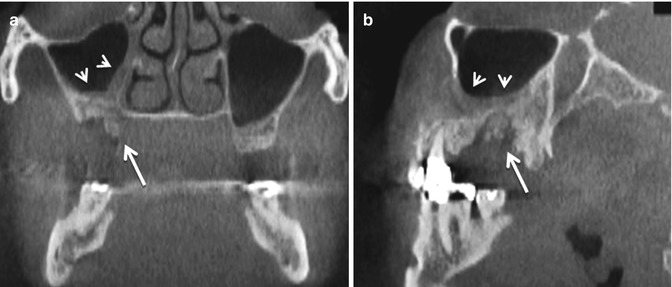
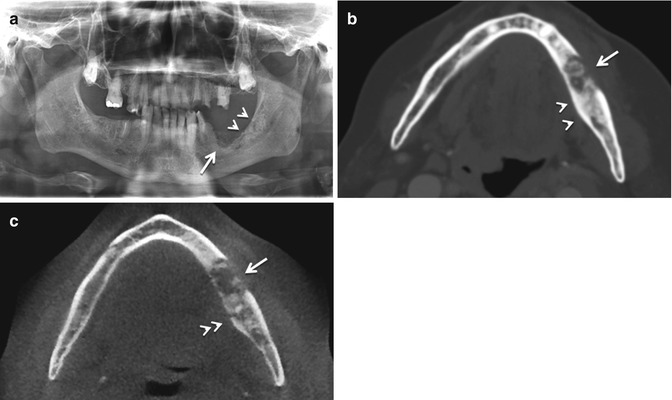

Fig. 6.5
A 73-year-old male clinically presenting with signs of sinusitis and exposed bone in the right posterior maxilla. (a) Coronal and (b) sagittal sections derived from CBCT data. Large arrows are depicting a sequestrum. Arrowheads show mucosal thickening in the right maxillary sinus as radiologic correlate to maxillary sinusitis due to BRONJ

Fig. 6.6
A 69-year-old male patient received intravenous bisphosphonate therapy with zoledronate (4 mg/month) due to osseous metastases from prostate carcinoma. (a) Panoramic radiograph. Large arrow is showing a radiolucent area corresponding to alveolar margin osteolysis. Posterior to the osteolysis, the two arrowheads depict osteosclerosis with disorganized medullary trabeculation and “cotton-wool”-like appearance. (b) Multislice computed tomography (MSCT). The large arrow indicates the osteolytic area; the two arrowheads indicate the osteosclerosis. In contrast to the panoramic radiograph, sequestration is visible as well (within the osteolytic area). (c) Cone-beam computed tomography (CBCT). Osteolytic area can be seen as well (large arrow). Additionally, lingual cortical disruption becomes evident in the shown layer (consecutive arrowheads)
Magnetic Resonance Imaging (MRI)
Free from ionizing radiation, MR imaging should be preferentially performed in 1.5 T or 3 T MR units, which may use the full spectrum of the modern sequences that provide “state-of-the-art” 2D and 3D T1- and T2-weighted imaging [9, 16, 21]. New MR scanners are also offered with multiple channel head/neck coils (up to 32 channels) that enable superior spatial resolution (in submillimeter range) in reasonable acquisition time for the patient. Besides the conventional morphological imaging, which has to be enhanced by contrast agent administration and suitable saturation of the fat planes in extracranial head, new functional MR imaging techniques (i.e., perfusion, diffusion) are available and may facilitate early disease diagnosis or monitoring in the future. Nonetheless, preliminary studies failed to demonstrate any strong supporting evidence in clinically manifested cases [37] as well as in the early stage of non-traumatic osteonecrosis models [38].
MR imaging of BRONJ is complementary to CT imaging revealing signal intensity alterations in a homogeneous pattern or affecting the periphery of the lesion in a band-like pattern [16], which has also a close correlation to the “bone-within-bone” appearance often seen in CT [16, 39]. In general, BRONJ is typically associated with decreased signal intensity on T1-weighted images and variable signal intensity changes on T2-weighted or short inversion time inversion-recovery (STIR) images and contrast-enhanced images [6, 7, 16, 40]. Typically, low T1 signal (reflecting low water content) in open wounds is associated with intermediate or slightly increased signal intensity on T2-weighted images (reflecting edema and inflammation) (Figs. 6.7, 6.8, and 6.9). Rather than T1-weighted images, the T2 signal intensity of the abnormalities, possibly associated with the disease stage including early cases with intermediate symptoms, is not variable, thus not pathognomonic and should be meticulously appreciated together with the CT findings, which may reveal subtle changes (i.e., focal hyperdensity) [6, 16, 40]. Generally, little information has been published about the early stages of BRONJ because they are not typically imaged with MR imaging or because the unexposed bone does not raise the suspicion of BRONJ. In doubtful cases (i.e., ambivalent signal on T1- and T2-weighted images), signal changes in gingival region, inferior alveolar nerve, and neighboring soft-tissue MR imaging, not readily appreciated, even in the contrast-enhanced CT also due to metal artifacts that may obscure the lesions in CT, may suggest BRONJ (Fig. 6.10). The involvement in MRI may appear more extensive after contrast enhancement than in CT [9, 41], but imaging-based disease quantification should preferably encounter native T1- and T2-weighted findings though the latter usually overestimate the disease extent compared to intraoperative findings [9, 21] or offer no significant additional information for the resection margins [42]. Up to now and partly due to study design problems, there are no longitudinal studies reporting on the clinical fate of “silent” changes seen in CT or MRI not concordant to the classical BRONJ appearance.
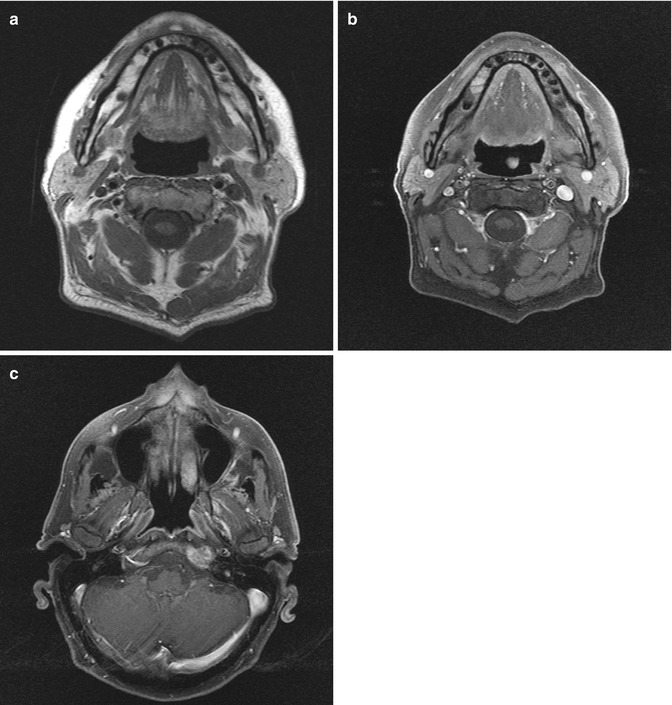
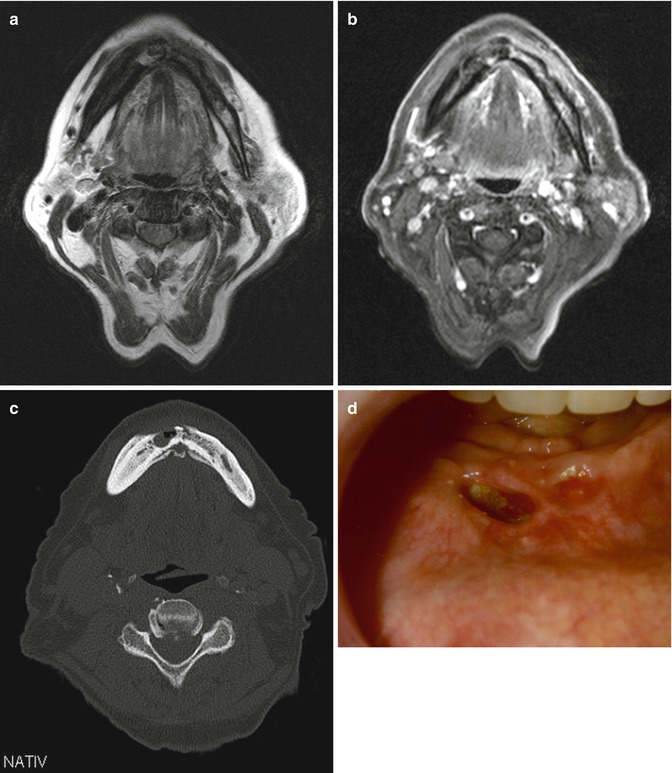

Fig. 6.7
(a–c) A 61-year-old woman with breast cancer and symptomatic osteonecrosis. Axial T1-weighted image (a) shows focal lesion of osteonecrosis in the left mandible as hypointense zone without cortical affection. After gadolinium administration and fat saturation (b), the lesion does not demonstrate significant enhancement. Adjacent fat-saturated, post-contrast T1-weighted MR image shows enhancing metastatic lesion in the left middle skull base (c)

Fig. 6.8
(a–d) A 50-year-old woman with breast cancer. Axial T2-weighted image (a) shows pathologic mesial fracture in the mandible as well as decreased marrow signal intensity with cortical affection and hyperostosis on the right side, accompanied by soft-tissue changes in the labial and buccal premandibular region. The soft-tissue changes and the affected bone marrow, especially on the left side, show avid enhancement in fat-saturated T1-weighted image (b). The corresponding axial CT image (c
Stay updated, free dental videos. Join our Telegram channel

VIDEdental - Online dental courses


